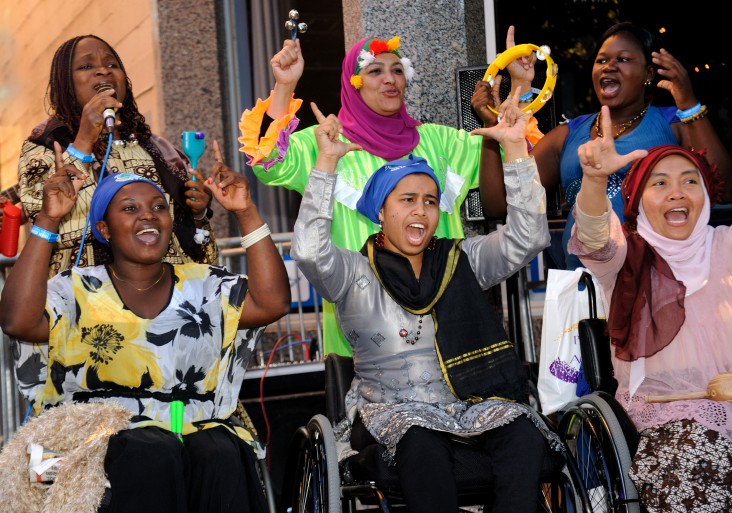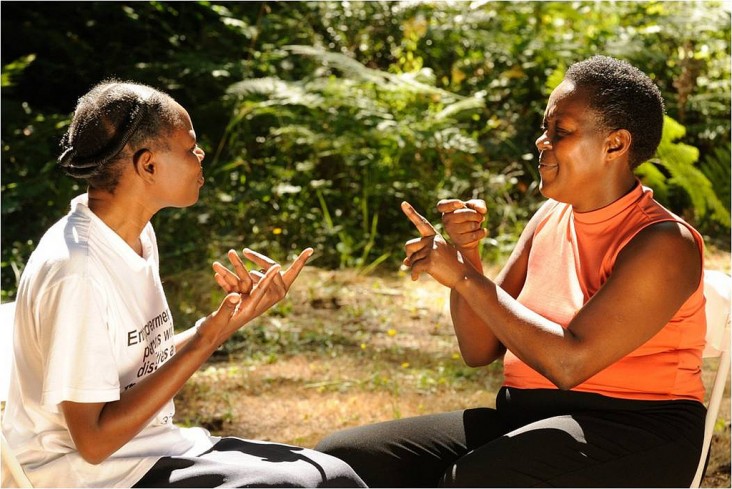- What We Do
- Agriculture and Food Security
- Democracy, Human Rights and Governance
- Economic Growth and Trade
- Education
- Ending Extreme Poverty
- Environment and Global Climate Change
- Gender Equality and Women's Empowerment
- Global Health
- Water and Sanitation
- Working in Crises and Conflict
- U.S. Global Development Lab

Persons with disabilities are the world’s largest minority, representing 15% of the global population. 80% of this population live in developing countries.
Women and girls with disabilities are subjected to multiple layers of discrimination. Based on their gender and disability status they often face “double discrimination”. This inequality is exacerbated for women and girls with disabilities who are members of marginalized ethnic or racial groups or part of the lesbian, gay, bisexual, transgender and intersex community.
Unemployment rates are highest among women with disabilities. The United Nations estimates that 75 percent of women with disabilities are unemployed and women with disabilities who are employed often earn less than their male counterparts and women without disabilities. Gender disparities also exist in education. While the overall literacy rate for persons with disabilities is 3 percent, UNESCO estimates that it is just 1 percent for women and girls with disabilities.
Women and girls with disabilities often face disproportionately high rates of gender-based violence, sexual abuse, neglect, maltreatment and exploitation. Studies show that women and girls with disabilities are twice as likely to experience gender-based violence compared to women and girls without disabilities. Women with disabilities are often denied reproductive healthcare and at times are even subjected to forced sterilization. When healthcare services are available, they may not be physically accessible for women with varying types of disabilities, or healthcare providers don’t know how to accommodate them.
The exclusion and violence against women and girls with disabilities in any country carries heavy financial and social consequences. Discrimination against persons with disabilities hinders economic development, limits democracy, and erodes societies. Perhaps because of the challenges they face, women and girls with disabilities are poised to be leaders within their communities and can greatly contribute to the economic development of their countries.

Disability inclusion is USAID policy. The agency supports disability-specific programs to address targeted needs, and seeks to integrate disability into all our programs. The USAID Disability Policy requires the inclusion of persons with disabilities in our programs, stating that:
- Issues related to disability are integral to international development
- Consultation with members of the disability community is critical
- Investing in and strengthening disabled people’s organizations is vital in promoting the human rights of persons with disabilities
USAID is committed to empowering and including women and girls with disabilities. Here are just a couple examples of the programs we support:
- Mobility International USA’s Women’s Institute on Leadership and Disability (WILD), supported by the USAID Leadership, Management and Governance Project, brings together emerging women leaders with disabilities from Africa, Asia, Eurasia, Latin America, and the Middle East to strengthen leadership skills, create new visions, and build international networks of support for inclusive international development programming. Christiana Yaghr of Ghana, who works with the Ghana National Association for the Deaf, participated in the WILD program. Read her story here. To watch a video of the WILD program, click here.
- In Vietnam, women with disabilities are gaining employment in the Information and Technology (IT) field. Since 2007, USAID and Catholic Relief Services have collaborated with the Hanoi College of Information Technology and Van Lang University in Ho Chi Minh City to provide training in advanced computer skills, such as graphic design, 3D modeling and web development, for youth with disabilities from all over Vietnam. To date, the program has trained more than 700 students with disabilities in Hanoi and Ho Chi Minh City, and over 80 percent of graduates have since found jobs. Read about Trinh Thi Vuong, a young woman from the southern province of Binh Thuan who completed the IT training course and is now employed.
Resources:
- Guide on How to Integrate Disability into Gender Assessments and Analyses. (October 2010) [PDF, 192KB]. This document serves as a “how to” guide on including women and men with disabilities into USAID’s gender assessments and analyses with background information on persons with disabilities as well as considerations specific to the issue of disability.
- Towards Gender Equality in Europe and Eurasia. (May 2012) [PDF, 1.6MB]. This toolkit has been prepared to provide USAID Mission Staff working in the E&E region with a resource for conducting gender analysis in the context of project design. The Toolkit dedicates a section with key guidance and considerations specific to Gender & Disability.
- Women with Disabilities in the Europe & Eurasia Region. (August 2012) [PDF, 950KB]. The study draws findings from a gender analysis to reveal challenges faced by women with disabilities, in contrast with the challenges facing men with disabilities, in the E&E Region. The report also provides recommendations for improving programming to meet the needs of women with disabilities.
- The UN Convention on the Rights of Persons with Disabilities specifically outlines the rights of women and girls with disabilities. To date, 154 countries have signed and ratified this global human rights treaty.







Comment
Make a general inquiry or suggest an improvement.